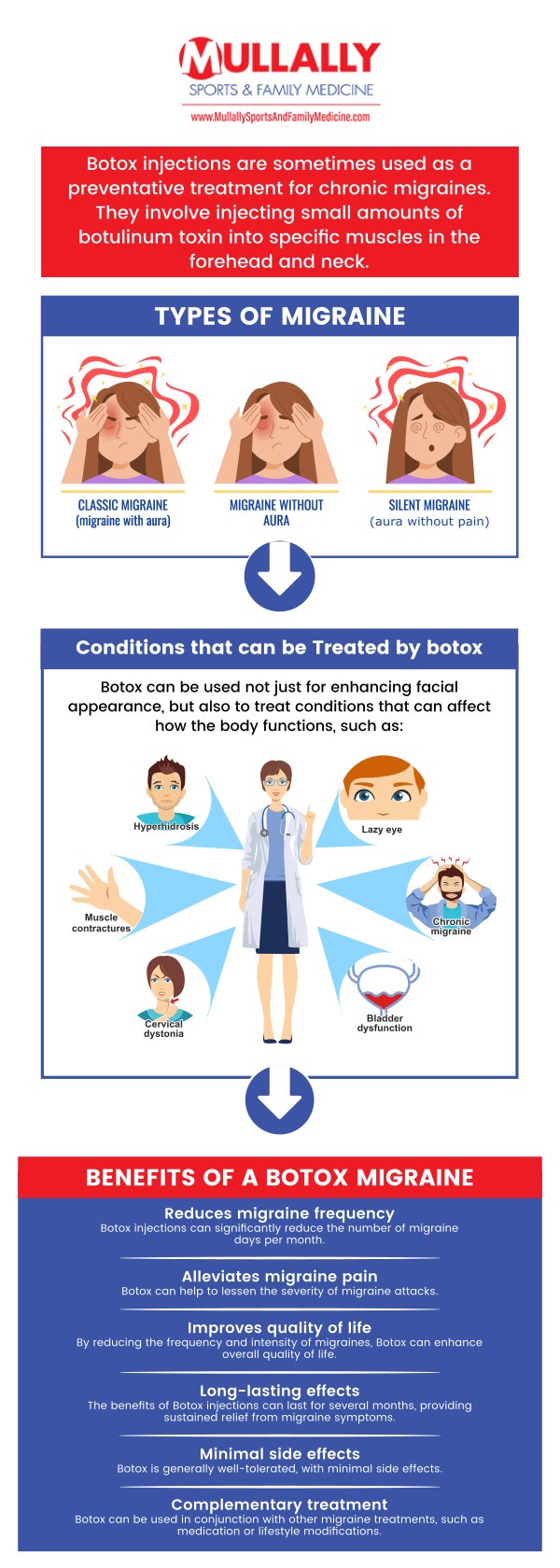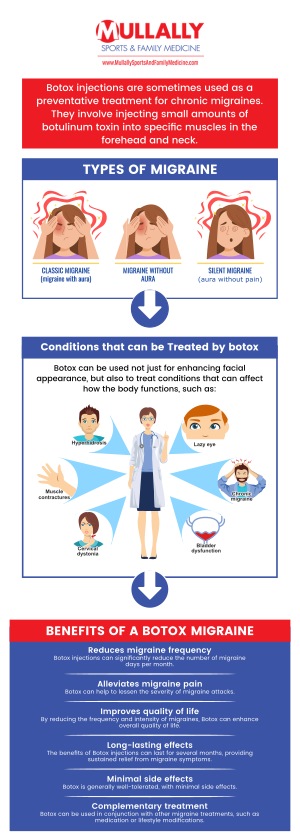Benefits of Botox for Migraines Q&A
At Mullally Sports and Family Medicine in Crown Point, IN, Botox offers significant relief for individuals suffering from chronic migraines. By targeting specific nerve pathways, Botox can reduce the frequency and severity of migraine attacks, providing a non-invasive and effective treatment option. This approach allows patients to experience improved quality of life with fewer migraine-related disruptions. For more information, contact us or schedule an appointment online. We are conveniently located at 11275 Delaware Pkwy Suite A, Crown Point, IN 46307.




Table of Contents:
How does Botox help with migraines?
How effective is Botox for treating migraines?
How frequently should I get Botox injections for migraines?
What are the potential side effects of Botox for migraines?
Is Botox for migraines covered by insurance?
Botox, a potent neurotoxin initially associated with aesthetic enhancements, has found its therapeutic relevance in the field of medicine, including the treatment of migraines. Migraines are severe, throbbing headaches often accompanied by nausea, vomiting, and an increased sensitivity to light and sound. Botox can help manage this debilitating neurological condition by temporarily blocking the transmission of certain pain signals between the nerves and the brain.
The application of Botox in migraine management involves injecting the neurotoxin into specific areas such as the forehead, neck, and shoulders, where patients experience tension or pain. Botox reduces muscle activity in targeted areas, which helps alleviate tension and inflammation, common triggers for migraines, thereby lowering the frequency and intensity of migraine episodes.
It’s important to understand that Botox is not a cure for migraines but serves as a preventive measure. This treatment is typically recommended for patients who suffer from frequent migraines, defined as headaches that occur 15 or more days each month.
At Mullally Sports and Family Medicine, we ensure that patients are well-informed about the potential benefits and risks of Botox treatment for migraines. Although Botox can greatly decrease the frequency and intensity of migraines, it may not be effective for everyone and could lead to temporary side effects, including bruising, swelling, and muscle weakness. Therefore, we encourage an open conversation with our healthcare providers to assess whether Botox is the right treatment for your migraines.
The effectiveness of this treatment is backed by extensive research, including various clinical trials and studies. Botox treatment for migraines involves temporarily weakening the muscles that contribute to headache pain, thereby reducing the intensity of migraines. This is achieved by blocking the release of certain chemicals involved in the transmission of pain signals from nerves to the brain.
Factors such as the dosage, number and location of injection sites, patient characteristics such as age, gender, and migraine history, and trigger avoidance such as stress, sleep disturbances, and dietary factors, will be considered to provide the most effective treatment plan for you.
Botox doesn’t work immediately and the maximum effect occurs around six weeks after the injection. Therefore, close monitoring and adjusting treatment plans as necessary ensures the most effective relief from chronic migraines. Although Botox carries potential side effects, these are generally mild and temporary.
These injections are typically administered every three months, or every 12 to 16 weeks, with this schedule based on the duration of the drug’s effects. However, the frequency may differ based on your individual needs, how you respond to the treatment, and your overall health.
Botox functions by inhibiting specific chemical signals from nerves that trigger muscle contractions. For chronic migraines, Botox is thought to block the signals that initiate a migraine attack. This treatment is designed to substantially decrease the frequency and intensity of migraines, focusing on prevention rather than treating an attack once it starts.
At our practice, we determine the optimal injection interval and treatment schedule through regular follow-up appointments. Our medical professionals will assess the effectiveness of the treatment, monitor any side effects, and adjust the injection schedule as necessary. After your initial treatment, we will closely monitor your response to Botox and adapt your treatment schedule accordingly.
It’s important to remember that Botox is a preventive treatment, meaning it’s crucial to maintain consistent treatment over time to achieve and maintain optimal results. However, Botox is not a cure for migraines. It’s a treatment designed to help manage this chronic condition.
As with any medical procedure, Botox treatment carries potential side effects, which can vary from mild to severe. While many of our patients find significant relief from their debilitating headaches, we believe in full transparency and patient education.
• Temporary Injection Site Effects: It’s common to experience pain, swelling, or bruising at the injection site post-treatment. Some patients also report headaches or a sensation of pressure in the head.
• Neurological Effects: Since Botox blocks nerve signals to the muscles, temporary muscle weakness may occur. Reported side effects include drooping eyelids, double vision, and loss of strength in the treated areas. Additionally, neurological effects such as dry mouth, hoarseness, or changes in voice have also been observed.
• General Side Effects: After receiving Botox injections, some patients may experience flu-like symptoms, such as fever, chills, or body aches. Fatigue and nausea or vomiting are also possible general side effects.
• Serious Side Effects (Rare): These include difficulty swallowing, speaking, or breathing, which can occur if the drug spreads beyond the injection site. Severe muscle weakness or paralysis, irregular heartbeat, loss of bladder control, vision problems, and allergic shock are other serious but rare side effects.
Remember, these side effects are typically temporary, subsiding as your body adjusts to the treatment. However, if you notice that they persist or worsen, or if you experience any significant side effects, it’s crucial to promptly consult a healthcare professional. Not everyone will encounter these side effects, and many patients gain significant relief from their migraines with Botox treatments.
Navigating the financial aspects of this treatment, such as insurance coverage, can be complex. To aid our patients in this process, we’ve put together a guide on understanding insurance coverage for Botox for migraines.
Insurance Coverage for Botox for Migraines.
Insurance companies may cover Botox for migraines, but this is dependent on the patient’s specific insurance plan and the insurer’s policies. Typically, insurers require the patient to have a diagnosis of chronic migraines, defined by the International Headache Society as having at least 15 headache days per month for over three months. They may also require evidence of failure of previous preventive migraine treatments and significant improvement with Botox injections.
Various insurance plans provide different levels of coverage for Botox treatments for migraines. Commercial insurance plans, Medicare, and Medicaid all have specific policies regarding coverage. Even with insurance coverage, it’s important to recognize that you may still have out-of-pocket costs depending on the specifics of your plan.
Most insurers require prior authorization for Botox for migraines. This involves submitting a request to the insurer, supported by medical documentation demonstrating the patient’s need for treatment. Should your claim be denied, you may have the option to appeal the decision.
At Mullally Sports and Family Medicine, our team is here to assist you in this process. We can help provide the necessary documentation and guidance to make this process less daunting. Our goal is to ensure our patients have access to the treatments necessary for a healthy, productive life. Reach out to us to discuss your options for managing migraines, including the benefits and risks of Botox treatment. We serve clients from Crown Point IN, Winfield IN, Schererville IN, St. John IN, Cedar Lake IN, Munster IN, Lowell IN, DeMotte IN, as well as other Northwest Indiana locations.

Check Out Our 5 Star Reviews


Additional Services You May Like

Additional Services You May Like
- Acute and Chronic Illness
- Annual Wellness Exams
- Concussion Management
- Lab Testing
- Medical Weight Loss Management
- Primary Care
- PRP Injections
- Regenerative Cell Therapy
- Same Day Sick Visits
- Shockwave Lab
- Actinic Keratosis
- Allergy Care
- Botox for Migraine
- Cosmetic Skin Treatment
- Cyst Removal
- Ear Wax Removal
- EKG
- Flu Shots
- Fracture
- Immunizations
- Laceration Repairs
- Moles
- Molluscum Contagiosum
- Mullally Medspa Services
- Nebulizer Treatment
- Nutrition And Exercise Management
- Pregnancy Testing
- Pulse Oximetry
- Respiratory Care
- Skin Tag Removal
- Spirometry
- Strep and Flu
- Surgical Clearance
- TB Testing
- Ultrasound Guided Injections
- Warts
- Women’s Health
- X-Ray
- EPAT Therapy
- EMTT Therapy
- Pediatrics




